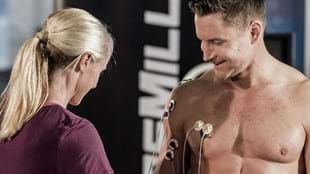Jinger Gottschall, PhD, is an Associate Professor at The Pennsylvania State University, and former triathlete who learned first-hand the injury-inducing effects of doing nothing but cardio exercise. She has subsequently led numerous studies into the effectiveness of various exercise regimes and works closely with Bryce Hastings, Les Mills Head of Research, to test all sorts of exercise programming. When it comes to getting the best results from the time you spend working out, this woman knows the way to go.
You’ve dedicated your career to academic fitness research but you’re also a certified instructor and gym owner too, so I’m sure you’ve seen plenty of different approaches to exercise. What do you think makes the most effective exercise?
Effective exercise doesn’t just come down to one workout, it’s a regime – and variety is key. One of the most comprehensive studies I’ve led is the Get Fit Together study, which highlighted how following the ACSM guidelines for the combination of cardio, strength and flexibility training is ideal. It also highlighted that starting exercise routines gradually minimizes injury and maximizes adherence, and that knowing and monitoring health numbers, such as body fat and cholesterol, improves commitment. And group workouts provide psychological and social benefits.
Have you been completely converted from solo triathlon training to being an advocate of working out in groups?
Absolutely, yes! Group fitness classes can drive amazing results for anybody. For those just starting out on their exercise journey it’s a great way to motivate in a more social environment where you have more adherence because of the instructor. But studies show group workouts – specifically High-Intensity Interval Training (HIIT) – are also hugely beneficial for frequent exercisers and serious athletes. I’ve led studies with soccer players and runners as well as trained rugby and field hockey teams, all of which have demonstrated the benefits of HIIT in a group.
Why do you think it’s important people understand what makes exercise effective, and the science behind their workouts?
When it comes to choosing exercise options people always want stats and research to support their decisions – specifically around the amount of time they need to invest and how quickly they can see the benefit. But research can go beyond that, and it can help change traditional thinking. For instance, our BODYPUMP and Bone Density study – which was recently discussed in TIME magazine – was the first to highlight that heavy weight lifting is not necessarily the only option. Lifting light weights for high repetitions is extremely beneficial.
Of course research isn’t just relevant to selecting exercise options – we know that during a workout, when you appreciate why and what you are doing, you put in more effort. Essentially, when you understand the science behind the exercise it gives you confidence that what you’re doing is worth it.
There are loads of exercise fads and “science-based” workouts out there. How can we determine what’s actually credible?
It’s hard. There are all sorts of novel approaches that, in some way, will benefit your health, but it’s important that you consider the bigger picture – ideally you want exercise that will benefit your overall health as well as something you can do for a long period of time. You can also become a fact checker – making sure the information is published in a peer reviewed journal rather than a blog or newspaper article – or you can simply follow the guidance of a professional organization.
Are there any important insights that exercisers are missing out on?
I don’t think people know enough about quality training, and how to put their schedule together to maximize the time they spend working out. The importance of variety is key. We know from the Get Fit Together study that a combination of cardio, strength and flexibility training fosters long-term engagement and results. The value of variety has also been backed up by our recent injury survey, showing that injury incidence is reduced when you balance cardio exercise with flexibility and strength training. This is a matter close to my heart, as I was suffering injuries from cardio-based triathlon training when I was introduced to BODYPUMP, and that’s what led me to where I am today.
And of course, there are still a lot of people out there who don’t exercise regularly. We need to educate these people that exercise doesn’t have to be monotonous, it can be fun and there really are options for everyone. And, I can’t stress enough the benefits of starting slowly.
Much of your research highlights the value of easing your way into exercise – what’s your advice to those new to exercise?
I’m quite conservative with respect to people starting out, and if you’re new to exercise I suggest that for the first six months you increase your training load in just 10 per cent increments per week. As a result, you won’t be as sore, or frustrated – in many cases you’ll be wanting to do more, which really helps you fall for exercise. It’s around the six month mark that exercise becomes more subconscious and more of a part of your everyday life.
And advice for those who exercise regularly?
I know first-hand that HIIT is the key to transforming your fitness. Right now I’m more fit than I was when I was competing in triathlons, simply because I’m now doing two LES MILLS GRIT workouts a week – it’s that good! Of course my own personal experience isn’t the only evidence. Research shows that replacing one hour of steady state training with two LES MILLS GRIT workouts a week provides phenomenal results.
So you can get fitter than ever without increasing the time you spend working out? What makes it so effective?
Together Bryce Hastings, Corey Baird and I test and refine every LES MILLS GRIT workout before it hits the studio floor. Using Polar Team 2 heart rate monitoring we track the same group of exercisers on three different occasions, we then refine the movement patterns and workout structure to ensure participants consistently reach the 85 per cent to max heart rate zone for 20 out of the 30 minutes – there’s no other program that reaches this heart rate zone as consistently as LES MILLS GRIT. You’re in the optimal training zone for the optimal time, and as a result getting in the shape of your life takes less time than ever.
Tell us about what’s next. What are some of the other ways you’re exploring the most effective exercise?
Together Bryce and I have pulled together a weighty list of topics to cover, and studies to investigate, so watch this space. I’m particularly excited about testing the concept of IMMERSIVE FITNESS and exploring the unique benefits of adding a visual element to a workout. I’m also very excited to take our recent injury survey to the next stage and explore the best ways to train to avoid and recover from injury. And, given running is one of my favorite pastimes, I’m looking forward to finalizing the study into how the core training of CXWORX can benefit runners.








